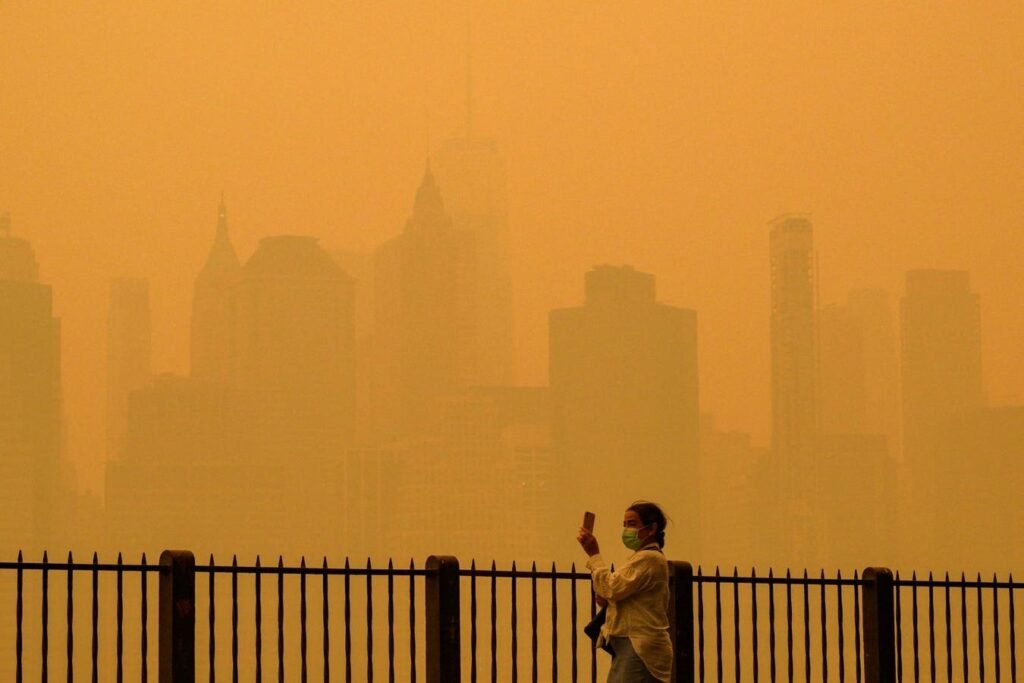TOPSHOT – A person wearing a face mask takes pictures of the horizon as smoke from wildfires in Canada … [+]
AFP via Getty ImagesExtreme heat and wildfires are contributing to unprecedented levels of air pollution in the United States, according to a new study.
The American Lung Association State of the Air Report 2024 warns that 131 million people now live in areas with unhealthy levels of air quality.
It also notes particulate pollution – often referred to as PM2.5 or soot – peaks at its most severe level in the 25 years since the report was published.
Tiny PM2.5 or soot particles can trigger asthma attacks, heart attacks and strokes and cause lung cancer.
The association’s national senior policy director, Kathryn Pruitt, said in an interview that these unprecedented levels of severe PM2.5 air pollution are being caused “almost exclusively” by the wildfires.
Pruitt said the impact of the wildfires is proving so severe that it is reversing many of the air quality gains achieved through cleaning up industrial and transportation emissions.
“Fire smoke creates a lot of fine particle pollution,” he told me. “And because the heat of the fires is so intense, the smoke plumes are driven far into the atmosphere and will spread over long distances.”
Pruitt said the top 25 cities in the U.S. for particulate matter pollution are all on the West Coast, and Pruitt said wildfires are mostly responsible.
According to the report, Bakersfield, California is the most polluted city for both short-term and year-round particle pollution levels.
The report also looks at which US cities are exposed to unhealthy levels of ground-level ozone air pollution, also known as smog, which can be caused by extreme heat levels.
Long Beach in Los Angeles has been named the city most polluted by ozone pollution.
Pruitt said extreme heat is increasingly becoming a health issue in the Southwest and western parts of the US
“We know it’s getting warmer,” he told me, “We know there are places in the Southwest where there’s a lot of oil and gas extraction, which creates a lot of precursor pollutants.
“But sunshine is really the critical piece of the puzzle, because the heat accelerates this photochemical reaction that produces ozone from these precursors.”
The report also highlights how people of color are disproportionately exposed to unhealthy air and are also more likely to live with one or more chronic conditions that make them particularly vulnerable to air pollution, including asthma, diabetes and heart disease.
The report found that a person of color in the US is 2.3 times more likely than a white person to live in a community with a failing grade on all three measures of air pollution examined in the report.
This year’s report uses dates from 2020, 2021 and 2022. Last year’s wildfire season will be considered in next year’s report.
“We’ve seen impressive progress in cleaning up air pollution over the past 25 years, thanks in large part to the Clean Air Act,” association president and CEO Harold Wimmer said in a statement.
“However, when we started this report, our team never imagined that 25 years into the future, more than 130 million people would still be breathing unhealthy air,” he added.
“Climate change is causing more dangerous air pollution. Every day that there are unhealthy levels of ozone or particulate pollution means that someone – a child, grandparent, uncle or mother – is struggling to breathe. We need to do more to make sure everyone has clean air.”




